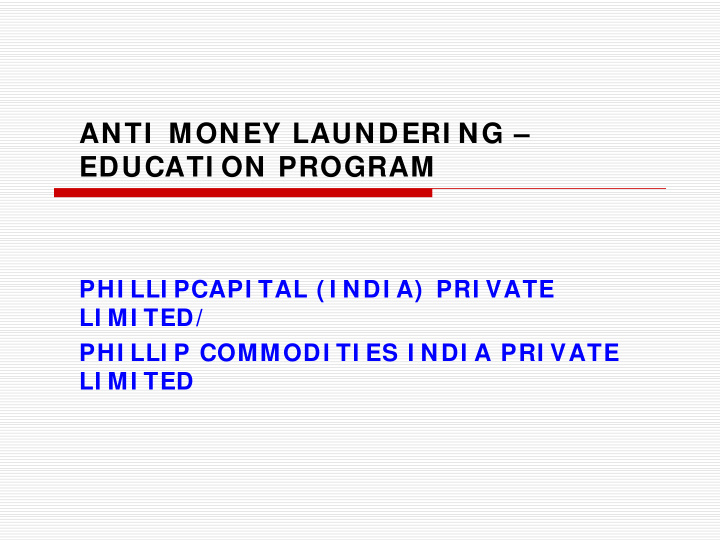



ANTI MONEY LAUNDERI NG – EDUCATI ON PROGRAM PHI LLI PCAPI TAL ( I NDI A) PRI VATE LI MI TED/ PHI LLI P COMMODI TI ES I NDI A PRI VATE LI MI TED
What is Money Laundering? � Money laundering is the process by which criminals attempt to hide and disguise the true origin and ownership of the proceeds of their criminal activities. � The term “Money Laundering” is also used in relation to the financing of terrorist activity (where the funds may, or may not, originate from crime).
What is Money Laundering? � It is a process of making dirty money clean. � Money is moved around the financial system again and again in such manner that its origin gets hidden. � Money generated from illegitimate source is converted into that derived from legitimate source
Key Stages of Money Laundering � Placement -of criminal proceeds into the financial system � Layering -of transactions to confuse the audit trail and distance the original source of funds � Integration -of funds back into the real economy as “clean and respectable money”
CLIENT DUTIES and OBLIGATIONS � 1. Subm it your source of incom e, financial details at regular intervals and as and w hen required by PhillipCapital ( I ndia) Pvt. Ltd. and/ or its group/ affiliates com panies. � 2 . Alw ays give funds and securities from account( s) held in your nam e only. � 3 . Any change in your status, address, etc should be im m ediately inform ed to PhillipCapital ( I ndia) Pvt. Ltd. and/ or its group/ affiliate com panies. � 4 . Provide correct details at the tim e of subm itting the Know your client ( KYC) form . 5 . Co-operate w ith PhillipCapital ( I ndia) Pvt. Ltd. and/ or its group/ affiliates com panies in carrying out its functions to tackle m oney laundering.
AML- India perspective � The Prevention of Money Laundering Act, 2 0 0 2 cam e into effect from 1 st July 2 0 0 5 � Necessary notifications/ rules under the said Act w ere published in the Gazette of I ndia on 1 st July 2 0 0 5 by the Dept of Revenue, Ministry of Finance, Governm ent of I ndia � Subsequently, SEBI issued necessary guidelines vide circular no. I SD/ CI R/ RR/ AML/ 1 / 0 6 dated 1 8 th Junuary 2 0 0 6 to all securities m arket interm ediaries registered under section 1 2 of the SEBI Act, 1 9 9 2 � Guidelines w ere issued in the context of recom m endations m ade by the Financial Action Task Force ( FATF) on anti-m oney laundering standards. � SEBI issued m aster circular I SD/ AML/ CI R-1 / 2 0 1 0 on February 1 2 , 2 0 1 0 consolidating all the requirem ents/ obligations issued w ith regard to AML/ CFT till February 1 2 , 2 0 1 0 � Also SEBI issued necessary circulars from tim e to tim e.
Applicability of PMLA Act � Banking company � Financial institution � Intermediary (which includes a stock broker,sub-broker, share transfer agent,portfolio manager, other intermediaries associated with securities market and registered under section 12 of the SEBI Act,1992)
Specific record of transactions prescribed under Rule 3,notified under PMLA 2002 � All cash transactions of the value of more than Rs. 10 lacs or its equivalent in foreign currency � All series of cash transactions integrally connected to each other which have been valued below Rs. 10 lacs or its equivalent in foreign currency where such series of transactions take place within one calendar month & aggregate value of such transactions exceeds rupees ten lakh � All suspicious transactions whether or not made in cash and including, inter-alia, credits or debits into from any non monetary account such as d-mat account, security account maintained by the registered intermediary. � For the purpose of suspicious transactions reporting, apart from ‘transactions integrally connected’,’transactions remotely connected or related should also be considered.
Thank You For any clarifications / grievances please write to us at customeraffairs@phillipcapital.in
Recommend
More recommend